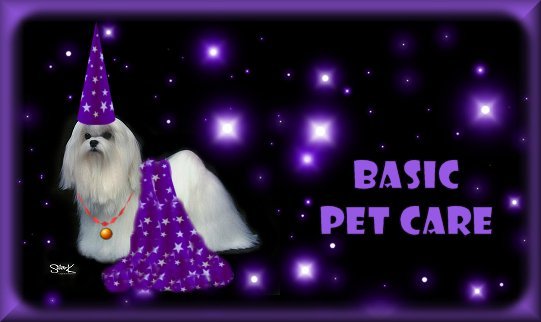 |
Maltese Tear Staining
By Tonia Holibaugh
Rhapsody Maltese
In showing Maltese for my clients as well as being a breeder/owner myself, tear staining has always been an annoying aspect of having white dogs. Although, genetics do play a part in tear staining, I find environment and stress play the biggest part in dogs staining. Any dog CAN have a tear staining issue .... no dog is immune to this problem.
Let me preface this discussion with a disclaimer:
The information here is for the use of encouraging education in caring for your dogs. I am not a licensed veterinarian. All medication given to your dog should be under the consultation of a licensed veterinarian.
Most tear staining is due to a low grade systematic infection. This can cause the enzyme levels in the dog's bodily fluids to be "off" and therefore cause excessive staining. This systematic imbalance can be caused by simple stress or it can indicate an underlying health issue.
Tear Staining is the red/brown discoloration that can usually be found on a dog under the eyes and around the mouth. In some more progressed states you can also find staining on the feet or around the genital areas. Although this is primarily an aestetic problem, it is an issue that should be addressed as it is always a medically based. A small staining problem in the beginning can end up being the first signs of a more serious underlying health issue that could surface at a later point.
If you have not had the experience of dealing with this issue previously, at this point I would discuss this issue with your veterinarian. Unfortunately, some vets do not think tear staining is an actual problem. If your vet responds this way, either change vets or talk to your breeder or someone with more experince.
As a first attempt to treat mild tear staining, many vets/breeders treat tear stain with an oral antibiotic. The most prevalent antibiotic used intially is Tylan Soluable Powder. Tylan powder is an antibiotic that is not commonly used with dogs. This is helpful, has most dogs will not have built up an immunity to this anitbiotic. It can be dissolved in their drinking water or be given orally daily. Different people use different doses. I would talk to your vet and breeder friends to see how they dose their dogs. Tylan is also a very mild antibiotic that has a secondary benefit of being useful in the treatment and prevention of some gastro-intestinal infections that can be picked up at dogs shows or other places with many dogs present. Although safe for dogs of all ages (except nursing puppies, mothers in whelp or nursing, and dogs on other medications), I would not recommend using it continuously. I would give them at least a week off every 3 weeks, to be on the safe side. Results do not happen overnight, but if after a 3 week period of time you don't see an improvement there probably is an underlying cause for the staining. Remember that the existing stain will not disappear but the hair will start to grown out white around the staining area.
If you have a darker stain that is resistant to a mild antibiotic treatment, you will need to more directly identify the specific health issue. First, visit your veterinarian to have a thorough examine, to look for ear infections, eye infection, blocked tear ducts and teeth issues. No antibiotic can fix some of these underlying health issues by themselves.
If you are having problems with tear staining and Tylan doesn't work, I suggest having a Culture and Sensitivity test run on the tearing residue. By just putting them on random antibiotics at the wrong doses, you could eliminate many common antibiotics by desensitizing the dog's system to them. Tylan is primarily made to battle microplasma in poultry and swine. This is not a commonly used canine antibiotic so if desensitizing occurs towards Tylan, it is not as damaging as it could be with other more commonly used canine antibiotics. Having the tearing cultured almost always is successful because the sensitivity report that tells your veterinarian what exact antibiotics the bacteria will respond to. This takes the guesswork out of the equation. In bad cases, I have found the bacteria to be resistant to most commonly used veterinary antibiotics. Tear staining can be attacked in two ways, with both oral antibiotics and with eye medication. Consult your vet for the proper doses.
Bad tear staining can be communicable. Constant wetness under the eyes is the perfect environment to develop a secondary baterial infection. This tends to turn into a form of Staph. Dogs licking each, other sharing water, using the same brushes can pass the bacteria. I Lysol my brushes every so often, or have dedicated brushes for certain dogs. I clean my dog room and puppy room with a bleach based solution and at completely other times an ammonia based solution, either can be mixed with Fabulouso. Many health issues (i.e. coccidia) are only killed by ammonia not bleach and vice versa. For day to day cleaning of my doggie areas, I use Odo-Ban or Simple Green. Regular washing with anit-bacterial dish washing liquid of all dog's water and food bowls is very important. Water and food bowls should be either ceramic, glass or stainless steel. Plastic and other materials can harbor bacteria. Once a month, the bowls can be soaked in a weak bleach solution for true sanatation and then washed in a normal fashion with soap and water.
Tear staining is usually has an environmental basis, too. In addition to antibiotics, I also use more holistic solutions:
**Using filtered or distilled water.
**Using ionizers in the rooms with the dogs for air purity, good ventilation for example exhaust fans, ceiling fans, open windows etc.
**Exposure to sunshine is crucial. Being outside with sunshine and clean fresh air is healthy for everyone, including dogs.
**Keeping your dogs clean with their hair out their faces is also important.
**Keeping your dogs environment clean is imperative.
**Keeping the filters in your air conditioning and heating systems clean.
Genetically, there are some bloodlines that are more prone to tearing then others. Hair growth on the eyerims, and more protruding eyes can be indicators. Prevalent problems with related dogs in different environments is also another good indicator. The predisposition to having health issues that cause tear staining can be genetic in origin. Look for trends in the dogs of that particular bloodline.
As for cleaning up the already stained hair. The key is to eliminate the cause of staining first and then you will find the stained hair will slowly fade and be much easier to whiten. There are ways to remove the stain once the staining has stopped. But, unless there is a crucial reason to remove the stain, always remember that staining is just a superficial thing and the ways to remove the stain are harsh to say the least.
Tearing is always a medical issue, with environment, care and genetics playing a part in the mix. Consistancy and time are always the keys to the best solution!
I hope this helps.
|
|

|



